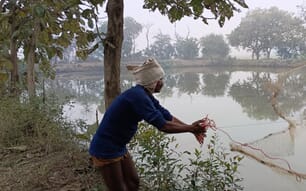Freshwater fish are less popular with consumers than marine or brackish water species so the development of freshwater aquaculture industry in Brunei Darussalam is still small compared to the other ASEAN countries, according to BruDirect, citing an article in Borneo Bulletin.
On average over the last five years, Brunei Darussalam's annual production was only 30 metric tonnes, which mainly comprised the major species cultured such as the common carp, nile tilapia, hybrid oreochromis and a few local species of snakehead, puntius and catfish.
Director of Fisheries Department, Hajah Hasnah Ibrahim, has highlighted the gap in the huge potential of developing freshwater aquaculture in her Leech at the launching of on-site training for development of freshwater prawn breeding and larval rearing.
She said: "The total area of land developed for the activities is about 13 hectares, operated and managed by 118 part-time farmers and consisting of 225 ponds. The ponds built are of various sizes from 100 to 500 square metres. Most of the ponds are operated by the people living in remote areas whose sources of protein, aside from meat and chicken, are freshwater fish collected from the rivers. The fish are produced for their own consumption and the balance is sold to the village community."
Recalling the research and development programmes started out by Fisheries Department, she explained: "The programmes started in 1982 as a pilot project in a small hatchery set up at the Muara fisheries station. The hatchery was constructed for the development of the culture of the freshwater prawn, Macrobrachium rosenbergii in Brunei Darussalam. All the post larvae produced up to 1986 was stocked in the local farmers' grow-out ponds. However, due to a limited number of grow-out ponds in the country, the department decided to implement restocking activities with excess post larvae carried out in 1987.
"This turned out to be a good programme since the wild stocks are depleted. It was found that the production in Temburong, for example, has declined from 600kg per day to 70kg per day. This is quite alarming, which prompted the department to engage a team of consultants to carry out a rapid assessment of the situation which will be completed in December, and we then will know the outcome and the reason of the decline in the production."
She said: "The potentials for developing freshwater aquaculture in Brunei is great because the country still has a lot of 'undistributed' inland area and the water is very clean and unpolluted. The government is planning to develop identified sites and provide them with basic access of road, electricity and water supply ready for commercial scale freshwater fish/prawn fanning to operate and at the same time a fish processing centre is developing steadily in the country for post-harvest activity.
"At the same time, the culture of freshwater giant prawns – Udang Galah – has a great future in Brunei as this prawn is popular among Bruneians and the market price ranges from US$10 to 15 per kilogramme.
"Shrimp farming is the most important and valuable sector of the aquaculture industry in this country," Ms Ibrahim told Borneo Bulletin.
The on-site training for the development of freshwater prawn breeding and larval rearing will run for 29 days until 9 November 2009 at the Sungai Jambu fish farm. The 23 participants comprise officers and technical staff from the Fisheries Department as well as Wasan Vocational School. The course is conducted by two aquaculture experts from Southeast Asian Fisheries Development Center, Aquaculture Department (SEADEC/AQRD).
The training is one of the efforts to increase the knowledge and skills of officers and technical staff through hands-on experience. It is hoped that the participants can implement programmes that could expand the aquaculture industry, especially the freshwater prawn industry.
Brunei Govt Supports Freshwater Aquaculture
BRUNEI DARUSSALAM - A training course is being held to boost freshwater aquaculture, with the full support of the Fisheries Department.




